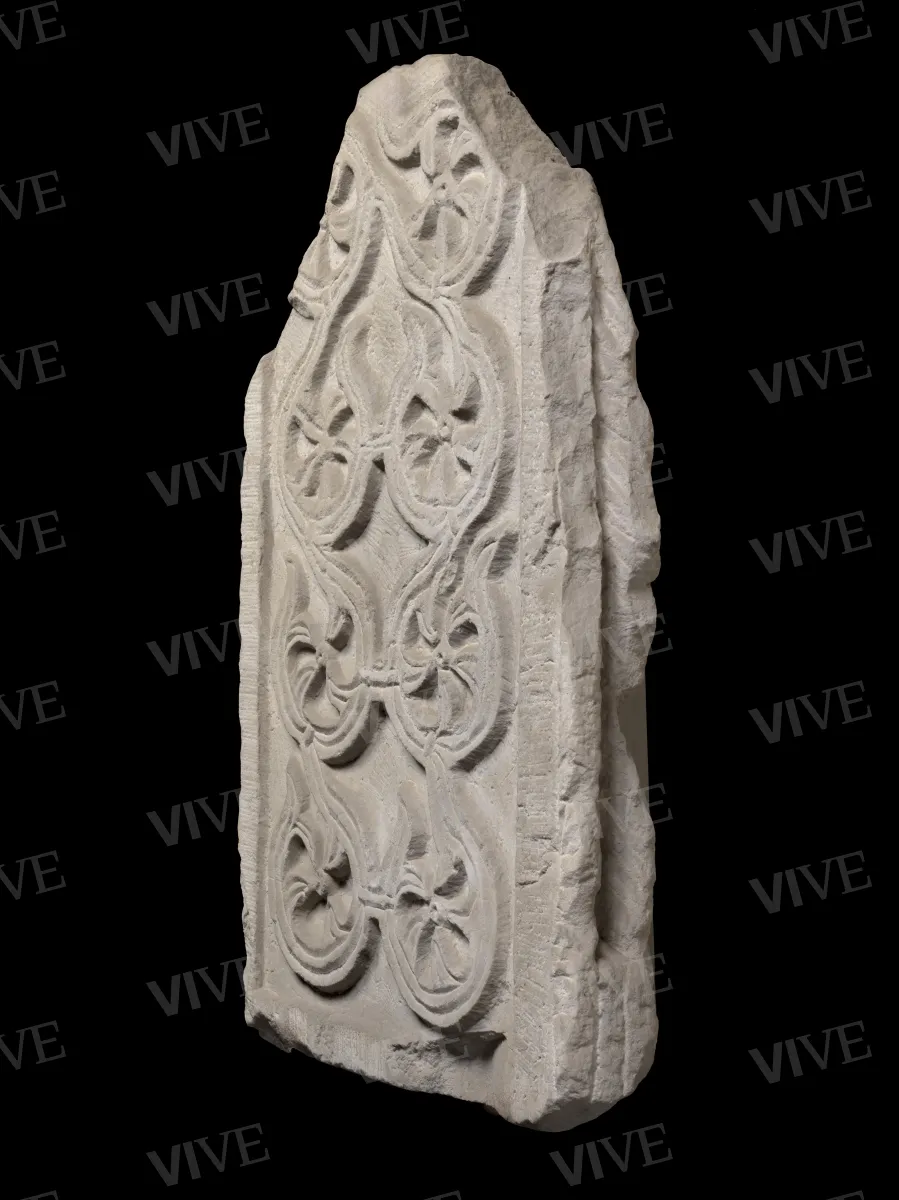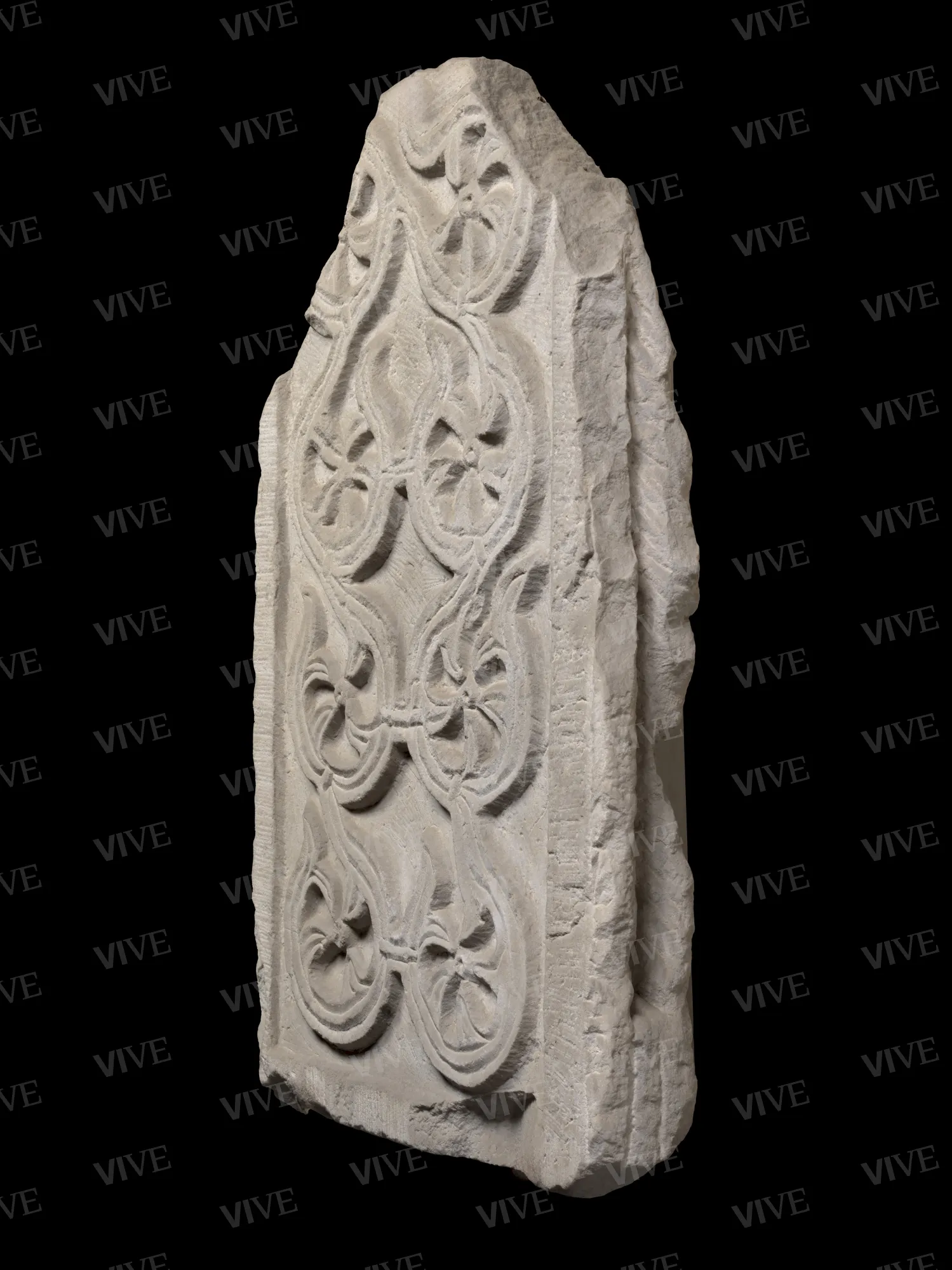Fragment of pluteus with propeller-bladed whorls
Roman milieu First half of 9th century
Fragment of a marble pluteus decorated with a double row of plant whorls with propeller-like blades, tapering to commas and filled with rotating rosettes, with a flat listel frame.
Fragment of a marble pluteus decorated with a double row of plant whorls with propeller-like blades, tapering to commas and filled with rotating rosettes, with a flat listel frame.
Details of work
Catalog entry
Within a smooth, flat listel frame unfolds a stylized double vine shoot geometrically organized in circular whorls of open, two-lined wicker ribbon motif tapering into a comma shape, bound by bands characterized by four or five two-lined wicker ribbon petals rotating ouround a central perforated bud.
Because of its size, which is incompatible with a doorpost or architrave, the fragment must be part of a presbyterial enclosure. This hypothesis is all the more likely considering the upper right gyre, now truncated at the roughly hewn edge, closes in on itself, interrupting its upward evolution, and then reconnects with the left gyre. This suggests that the pluteus was delimited at the top by the cornice alone, so that it measured around one meter in height. These measurements are consistent with those of the intact plutei at Santa Prassede (Pani Ermini 1974, figs. 58–61) and Santa Sabina (Trinci Cecchelli 1976, figs. 232–255) and, more generally, seen in slabs with a similar function from the early ninth century between Rhaetia and Rome (now reexamined in Roth-Rubi 2015, Roth-Rubi 2018).
The motif, known as “propeller blades,” which had already been elaborated as early as the sixth century in the proto-Byzantine context (Verzone 1963) and often found in early medieval Roman liturgical ornament sculpture in different variants (Kautzsch 1939, now Martorelli, Pettinelli 2022), translates the old iconographic theme of the arbor vitae or tree of life into abstract form. In many versions it in fact extends from a central stem, schematizing the tree in the form of a rectilinear rod (see, for example, San Giovanni a Porta Latina or Santa Maria in Cosmedin, Melucco Vaccaro 1974, fig. 31 and 109) and the leaves in rotating helices.
The stylized gyre-only form can be seen in Rome as early as the eighth century, as in the gyre decorating the ciborium arch in the catacomb of Sant'Alessandro (Betti 2005, fig. 120), from the demolition of an urban religious building and traced to several marble fragments from Grado—a sign of the continuous training of Roman stone carvers along the upper Adriatic between the eighth and ninth centuries—and also becomes extremely popular in the following century beyond Rome, as in the pillar from San Pietro ad Oratorium from the ninth century (Antonelli 2010, fig. 11).
The scheme of our fragment is linked to the trefoil decoration on the wellhead at San Giovanni a Porta Latina in Rome, dating to the second quarter of the ninth century (Melucco Vaccaro 1974, figs. 36–37). Although decidedly inferior in quality, here we have a double order of gyres and an asymmetrical progression of helices, variously spiraling clockwise and anticlockwise, without agreement along the same register. It is to this same overall chronological context that we can link the pieces that are stylistically most similar to our fragments, including the fragment of a ciborium arch from the basilica of Santi Bonifacio e Alessio (Trinci Cecchelli 1976, fig. 18), again in italic and simplified form; the slabs of San Saba (id, figs. 85–89) dating to the end of the papacy of Gregory IV (827–844); the fragmentary plutei with a double whorl within a flat listel frame from San Cosimato that were walled in the lapidarium of Santi Cosma e Damiano (Mazzanti 1896; Barclay Lloyd, Bull-Simonsen Einaudi 1998); and the fragment of pilaster or slab from San Martino ai Monti (Barsanti, Flaminio, Guiglia 2015, fig. 205), dated to the first half of the ninth century.
Valentina Brancone
Entry published on 12 February 2025
State of conservation
Fair. Roughly hewn on one of the short sides and chipped along the frame, possibly with a view to repurposing.
Restorations and analyses
2002–2003 (restoration curated by Maria Giulia Barberini and Maria Selene Sconci, conducted on the occasion of the layout of the Museo di Palazzo Venezia Lapidarium).
Provenance
Unknown;
Rome, from the early twentieth century at the Museo Artistico Industriale;
Rome, from 1957 at Palazzo Venezia.
Sources and documents
Rome, Archivio della Galleria Nazionale d’Arte Antica di Palazzo Barberini, Libro 5° dell’inventario, Fondo M.A.I., manuscript edited by V. Rosati, A. Ferrari, G. Ferrari, n.d. (early twentieth century), no. 41;
Ferrari Giulio, Museo Artistico Industriale di Roma. Catalogo delle collezioni, Rome 1906, 15;
Rome, Archivio del Museo del Palazzo di Venezia, Resoconto della riunione per la concessione degli oggetti del Museo Artistico Industriale in deposito al Museo di Palazzo Venezia (August 5, 1952, Prof. E. Lavagnino, Prof. A. M. Colini, Dr. C. Pietrangeli, Prof. A. Santangelo), with attached inventory, no. 1159;
Rome, Archivio del Museo del Palazzo di Venezia, inventorying the sculptures of the lower and upper loggias (manuscript inventory edited by Maria Vittoria Brugnoli, 1973).
References
Mazzanti Federico, La scultura ornamentale romana nei bassi tempi, in «Archivio Storico dell’Arte», s. II, II, 1896, pp. 33-57, 161-187;
Kautzsch Rudolf, Die römische Schmuckkunst in Stein vom 6. bis zum 10 Jahrhundert, in «Römisches Jahrbuch für Kunstgeschichte», III, 1939, pp. 3-73;
Verzone Paolo, La scultura decorativa dell’Alto Medioevo in Oriente e in Occidente, in Corsi di cultura sull’arte ravennate e bizantina, X, Ravenna 1963, pp. 317-388;
Melucco Vaccaro Alessandra, La Diocesi di Roma, to. III, La II regione ecclesiastica, Corpus della scultura altomedievale, VII, Spoleto 1974;
Pani Ermini Letizia, La Diocesi di Roma, t. I, La IV regione ecclesiastica, Corpus della scultura altomedievale, VII, Spoleto 1974;
Trinci Cecchelli Margherita, La Diocesi di Roma, t. IV, La I regione ecclesiastica, Corpus della scultura altomedievale, VII, Spoleto 1976;
Barclay Lloyd Joan, Bull-Simonsen Einaudi Karin, SS. Cosma e Damiano in Mica Aurea. Architettura, storia e storiografia di un monastero romano soppresso, Roma 1998;
Latini Massimo, Sculture altomedievali inedite del Museo Nazionale del Palazzo di Venezia in Roma, in «Rivista dell’Istituto Nazionale d’Archeologia e Storia dell’Arte», 57, 2003, pp. 113-152;
Betti Fabio, La Diocesi di Sabina, Corpus della scultura altomedievale, XVII, Spoleto 2005;
Antonelli Sonia, Decorazione architettonica altomedievale e arredi dai contesti monastici abruzzesi, in Somma Maria Carla (a cura di), Cantieri e maestranze nell’Italia medievale, Atti del Convegno di studio (Chieti - San Salvo, 16-18 maggio 2008), Spoleto 2010, pp. 187-234;
Roth-Rubi Katrin (in collaborazione con Sennhauser Rudolph), Die frühe Marmorskulptur aus dem Kloster St. Johann in Müstair, Ostfildern 2015;
Barsanti Claudia, Flaminio Roberta, Guiglia Alessandra, La Diocesi di Roma. La III regione ecclesiastica, Corpus della scultura altomedievale, VII, 2 voll., Spoleto 2015;
Roth-Rubi Katrin, Die frühe Marmorskulptur von Chur, Schänis und dem Vinschgau (Mals, Glurns, Kortsch, Göflan, Burgeis und Schloss Tirol), Ostfildern 2018;
Martorelli Rossana, Pettinelli Emanuela, La Diocesi di Albano Laziale, Corpus della scultura altomedievale, XXI, Spoleto 2022.












